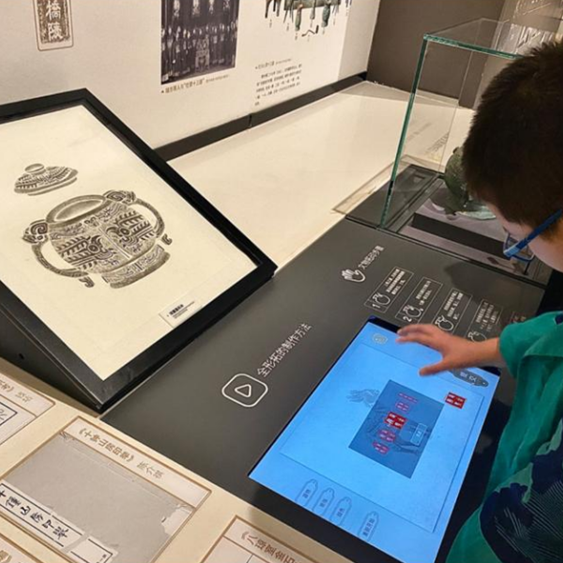การศึกษาผลกระทบของสภาพแวดล้อมดิจิทัลในพิพิธภัณฑ์ต่อประสบการณ์การรับรู้ของผู้เยี่ยมชม: กรณีศึกษาของเครื่องสำริดสมัยราชวงศ์โจวตะวันตก
DOI:
https://doi.org/10.69598/sbjfa270547คำสำคัญ:
สภาพแวดล้อมดิจิทัล, การจัดแสดงในพิพิธภัณฑ์, เครื่องสำริดสมัยราชวงศ์โจวตะวันตก , ประสบการณ์การรับรู้ของผู้ชมบทคัดย่อ
พิพิธภัณฑ์มีบทบาทสำคัญในการให้การศึกษา แต่ทว่าการจัดแสดงแบบดั้งเดิมมักไม่สามารถทำให้ผู้ชมเข้าใจวัตถุโบราณได้อย่างลึกซึ้ง โดยเฉพาะวัตถุที่มีคุณค่าทางประวัติศาสตร์และวัฒนธรรมสูง เช่น เครื่องสำริดสมัยราชวงศ์โจวตะวันตก สืบเนื่องจากการพัฒนาอย่างรวดเร็วของเทคโนโลยีดิจิทัล ส่งผลให้การจัดแสดงในพิพิธภัณฑ์เกิดความเปลี่ยนแปลงในระดับพื้นฐาน โดยเฉพาะการจัดแสดงมรดกทางวัฒนธรรมสภาพแวดล้อมดิจิทัลเสนอแนวทางใหม่ ๆ สำหรับการมีปฏิสัมพันธ์เปลี่ยนแปลงวิธีที่ผู้ชมมีส่วนร่วมและสัมผัสประสบการณ์การรับรู้ วิธีการนำเสนอภายใต้สภาพแวดล้อมดิจิทัลจึงมีความสำคัญเป็นพิเศษ การศึกษานี้ใช้วิธีการทบทวนวรรณกรรม การเก็บข้อมูลภาคสนาม และการวิจัยสหวิทยาการ เพื่อสำรวจการสร้างสภาพแวดล้อมดิจิทัลในพิพิธภัณฑ์ โดยมีเป้าหมายเพื่อเพิ่มพูนประสบการณ์การรับรู้ของผู้ชมเกี่ยวกับเครื่องสำริดสมัยราชวงศ์โจวตะวันตก การศึกษาวิเคราะห์คุณค่าทางประวัติศาสตร์และความหมายเชิงสัญลักษณ์ของวัตถุโบราณ การประยุกต์ใช้สภาพแวดล้อมดิจิทัลในพิพิธภัณฑ์ในปัจจุบัน และผลกระทบต่อการรับรู้ของผู้ชม ผลการศึกษาชี้ให้เห็นว่าเครื่องสำริดสมัยราชวงศ์โจวตะวันตกแสดงถึงประวัติศาสตร์อันยาวนานและสัญลักษณ์ทางวัฒนธรรมที่เข้มข้น สะท้อนโครงสร้างทางการเมืองและศาสนาของสังคมโบราณ เทคโนโลยีดิจิทัลได้กลายเป็นทิศทางที่สำคัญสำหรับการพัฒนาการจัดแสดงในพิพิธภัณฑ์และนวัตกรรม การศึกษาทำให้การจัดแสดงน่าสนใจและเพิ่มพูนความรู้ในเชิงการศึกษา เพิ่มประสิทธิภาพการสื่อสารข้อมูลและแรงจูงใจในการเรียนรู้ของผู้ชมอย่างมาก ด้วยประสบการณ์ทางประสาทสัมผัสที่หลากหลายและการออกแบบที่เน้นการมีส่วนร่วมของผู้ชม สภาพแวดล้อมดิจิทัลในพิพิธภัณฑ์ส่งเสริมประสิทธิภาพในการเพิ่มพูนประสบการณ์การรับรู้ของผู้ชม ทำให้เนื้อหาทางประวัติศาสตร์ที่ซับซ้อนเข้าถึงได้สะดวกขึ้น การใช้เทคโนโลยีสื่อดิจิทัลอย่างเหมาะสมสามารถปรับปรุงประสิทธิภาพการเรียนรู้ของผู้ชมและเพิ่มพูนความเข้าใจ ตลอดจนความชื่นชมในมรดกทางวัฒนธรรม
Downloads
เอกสารอ้างอิง
黄秋野. (2008). 博物馆中的数字化展览及展示技术研究.硕士学位论文, 江南大学.
倪玉湛. (2011). 夏商周青铜器艺术的发展源流. 博士学位论文. 苏州大学.
阎宏斌. (1988). 宝鸡林家村出土西周青铜器和陶器. 文物,(6), 92.
彭裕商. (2002). 西周青铜器窃曲纹研究.考古学报(4), 421-436.
雒有仓.(2007). 商周时期青铜器铭文的综合研究.博士学位论文, 陕西师范大学.
许俊臣 & 刘得祯. (1985). 甘肃宁县宇村出土西周青铜器. 考古 (4), 389.
何景成. (2005). 商周青铜器族氏铭文研究. 博士学位论文. 吉林大学. 8
黄秋野 & 叶苹. (2008). 数字化博物馆展览设计新构想. 美术大观 (12), 74-75.
孙玉洁. (2021). 数字媒体艺术沉浸式场景设计研究. 博士学位论文. 中国艺术研究院.
王渭清 & 赵磊. (2023). 宝鸡出土西周青铜器铭文的文学史价值. 宝鸡文理学院学报(社会科学版) (3), 17-25.
来因. (1981). 我国法律史上的一篇重要文献——西周青铜器"(亻朕)匜"铭文. 法学杂志 (2), 3.
Carci, G., Caforio, A., & Gamper, C. (2019). Digital technologies and museums: augmented reality, learning and audience development. Form@re - Open Journal Per La Formazione in Rete, 19(1), 274–286. https://doi.org/10.13128/formare-24619
Childs-Johnson, E. (2020). In The Oxford Handbook of Early China. Oxford University Press. https://doi.org/10.1093/oxfordhb/9780199328369.001.0001.
China's development and reform. (2020). OptiTrack, the virtual moving point, helps "Lost in the Treasure of the National Treasure" and opens up a new level of virtual reality [Online image]. Baidu. https://baijiahao.baidu.com/s?id=1673458075197214036&wfr=spider&for=pc
Chinese Painting and Calligraphy Exhibition. (2020). Western Zhou Dynasty Bronze Album – Hezun [Online image]. http://tq.eocan.com/2020/03/21275.html
He, J. (2005). Research on clan inscriptions on bronzes from the Shang and Zhou dynasties [Unpublished Doctoral dissertation]. Jilin University. [in Chinese]
Hijazi, A. N., & Baharin, A. H. A. (2022). The effectiveness of digital technologies used for the visitor's experience in digital museums: A systematic literature review from the last two decades. International Journal of Interactive Mobile Technologies (iJIM), 16(16), 142-159. https://doi.org/10.3991/ijim.v16i16.31811
Hong, X., & Xuan, L. (2022). From "Clan" to "People": The evolution of bronzeware and Zhou Dynasty political culture from the perspective of political communication. International Journalism, (8), 129-145. https://doi.org/10.13495/j.cnki.cjjc.2022.08.002
Huang, Q. (2008). Research on digital exhibition and display technology in museums [Unpublished Master’s thesis]. Jiangnan University. https://doi.org/10.7666/d.y1399165 [in Chinese]
Huang, Q., & Ye, P. (2008). New ideas for digital museum exhibition design. Art Panorama (12), 74-75. [in Chinese]
House of Document. (n.d.). Bronze Ornamentation [Online image]. https://www.doczj.com/doc/212027030.html
ISO. (n.d.). EPIC Ireland – AV Installations & Interactives: EPIC The Irish Emigration Museum [Online image]. https://isodesign.co.uk/projects/epic-ireland-av-installations-interactives
Johnsen, E. I. (2022). Snartemo hilt both [Online image]. Wikimedia Commons. https://commons.wikimedia.org/wiki/File:Snartemo_hilt_both.jpg
Lai, Y. (1981). An important document in the history of Chinese law: The inscription on the Western Zhou bronze vessel "(Ying) Yi". Journal of Law (2), 3. [in Chinese]
Lo Turco, M., & Calvano, M. (2019). Digital Museums, Digitized Museums. In: Luigini, A. (eds) Proceedings of the 1st International and Interdisciplinary Conference on Digital Environments for Education, Arts and Heritage. EARTH 2018. Advances in Intelligent Systems and Computing, vol 919. Springer, Cham. https://doi.org/10.1007/978-3-030-12240-9_41
Luo, Y. (2007). A comprehensive study of clan emblems and inscriptions on Shang and Zhou bronze vessels [Unpublished Doctoral dissertation,]. Shaanxi Normal University
Merleau-Ponty, M. (2010). Phenomenology of perception (D. Landes, Trans.). Routledge. https://doi.org/10.4324/9780203720714.
Museum Lab. (2023). ReInHerit a Museum: Immersive Performance at the Boccf [Online image]. https://museumlab.cyens.org.cy/project/reinherit-a-museum-immersive-performance-at-the-boccf/
Ni, Y. (2011). The development of bronze art in the Xia, Shang and Zhou dynasties [Unpublished Doctoral dissertation]. Suzhou University. [in Chinese]
Parry, R. (Ed.). (2013). Museums in a digital age. Routledge.
Patel, M., White, M., Mourkoussis, N., Walczak, K., Wojciechowski, R., & Chmielewski, J. (2005). Metadata requirements for digital museum environments. International Journal on Digital Libraries, 5(3), 179-192. https://doi.org/10.1007/s00799-004-0104-x.
Peng, Y. (2002). Study on the filched patterns of Western Zhou dynasty bronzes. Journal of Archaeology, (4), 421-436. [in Chinese]
People's Daily Online-Shaanxi Channel. (2022). Shaanxi released six important new archaeological discoveries, and the Baling site was selected [Online image]. http://sn.people.com.cn/BIG5/n2/2022/0124/c226647-35110445.html
Sogou Encyclopedia. (2021). Boju Li of the Western Zhou Dynasty: Cultural relic characteristics [Online image].https://baike.sogou.com/v68688555.htm
Starr, M. (2015). 3D printing produces a perfect replica of a sixth-century sword; A damaged sixth-century sword in a museum in Norway has been perfectly reproduced as new through 3D printing [Online image]. CNET. https://www.cnet.com/culture/3d-printing-produces-a-perfect-replica-of-a-6th-century-sword/
Sun, Y. (2021). Research on immersive digital media art scene design [Unpublished Master dissertation]. China National Academy of Arts. https://www.doc88.com/p-91699482268979.html [in Chinese]
Wang, W., & Zhao, L. (2023). Literary history value of Western Zhou bronze inscriptions excavated in Baoji. Journal of Baoji University of Arts and Sciences (Social Science Edition), (3), 17-25. [in Chinese]
Xu, J., & Liu, D. (1985). The bronzes of the Western Zhou dynasty were unearthed in Yu Village, Ningxian County, Gansu Province. Journal of Archaeology, (4), 389-352.
Yan, H. (1988). Western Zhou bronzes and pottery unearthed in Linjiacun, Baoji. Cultural Relics, (6), 92. [in Chinese]

ดาวน์โหลด
เผยแพร่แล้ว
รูปแบบการอ้างอิง
ฉบับ
ประเภทบทความ
สัญญาอนุญาต
ลิขสิทธิ์ (c) 2024 จู เจีย, อติเทพ แจ้ดนาลาว

อนุญาตภายใต้เงื่อนไข Creative Commons Attribution-NonCommercial-NoDerivatives 4.0 International License.
บทความนี้อยู่ภายใต้สัญญาอนุญาตครีเอทีฟคอมมอนส์ CC BY 4.0
ทัศนะและข้อคิดเห็นในบทความเป็นของผู้เขียน กองบรรณาธิการไม่จำเป็นต้องเห็นพ้อง และไม่รับผิดชอบต่อข้อคิดเห็นเหล่านั้น











